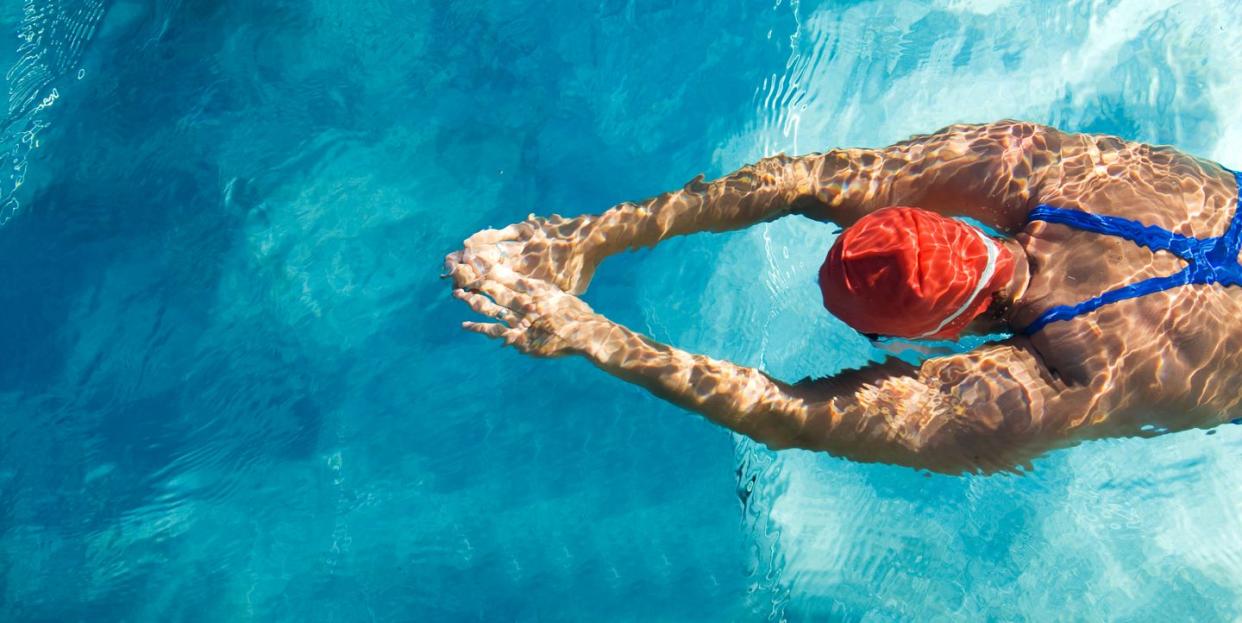How to Treat (and Prevent) That Itchy Chlorine Rash After a Day of Swimming

“Hearst Magazines and Verizon Media may earn commission or revenue on some items through the links below.”
If you’ve ever experienced dry, tight skin after swimming in a pool, chances are it’s due to the chemical that’s helping to keep the water clean: chlorine. For many, the substance causes a mild case of dry skin. For some, a full-on rash appears.
The reaction is called a chlorine rash and, as you can imagine, it’s not exactly comfortable. But does one itchy patch of skin mean you’re allergic to chlorine? Dermatologists confirm that experiencing this once doesn’t mean you’re doomed to a lifetime of sitting poolside while everyone else swims. Take the first step to getting back in the pool by diving right into our expert-approved tips for preventing and treating chlorine rash.
What is a chlorine rash, exactly?
A chlorine rash is a red, itchy rash that appears on your skin a few hours after you swim in a chlorinated pool or hot tub. It can cause itchy, red skin or even hives, according to the American College of Allergy, Asthma & Immunology (ACAAI).
A chlorine rash isn’t actually an allergic reaction, but it’s a form of irritant dermatitis—kind of like a minor chemical burn—that’s caused by hypersensitivity to chlorine, the ACAAI says. At the same time, chlorine dries out skin, and that can aggravate any other skin irritations you may have. “The same chemicals used to prevent contamination of a swimming pool can take a toll on your skin, leading to dryness, flaking, and rashes,” says Joshua Zeichner, M.D., a board-certified dermatologist in New York City.
When chlorine is combined with water, it forms hypochlorous acid, explains board-certified dermatologist Ife J. Rodney, M.D., founding director of Eternal Dermatology + Aesthetics in Maryland. “This acid can open the pores, breaking down the skin’s natural oils and moisture barrier, causing dryness,” she says. “The longer you stay in the water, the worse it gets.”
For people with sensitive skin, staying in chlorinated water for longer periods of time can lead to dermatitis, according to Dr. Rodney. Cue the itchiness and rash. While chlorine rashes can technically happen to anyone, they’re most common in people with repeated exposure to pools like active swimmers, lifeguards, and maintenance workers, says Dr. Rodney.
What are the symptoms of a chlorine rash? And what does it look like?
If your skin tends to be sensitive to chlorine, you may develop these chlorine rash symptoms, per the ACAAI:
Skin redness
Skin tenderness
Skin Inflammation
Itchiness
Skin lesions or rash
Scales or crust on the skin
Hives that appear suddenly and get bigger
How do you treat a chlorine rash?
There are a few things you can do to get relief. First, wash your body with clean water to try to remove any lingering traces of chlorine, Dr. Rodney advises. Then, use a gentle moisturizer, like La Roche-Posay Lipikar Balm AP+ Moisturizing Cream, right after you rinse off, she says.
If you’re itchy, she also suggests applying an over-the-counter hydrocortisone cream (for no more than a few days) to the areas that feel uncomfortable. “It’s safe yet effective at soothing your skin,” Dr. Rodney explains.
How to reduce your risk of a chlorine rash
Apply a balm before you swim.
Aquaphor or Vaseline are your friends here. “It creates a barrier that limits the contact of chlorine with your skin while you’re in the pool,” Dr. Rodney says. Just don’t forget the sunscreen if you’re swimming outdoors.
Dr. Rodney, who recommends mineral sunscreens for this, says you can apply SPF as the very last step, after applying a thin layer of ointment to moisturize and create a barrier on the skin.
Shower before and after you get in the pool.
Getting wet before you dive in can remove dirt and bacteria on your skin that can react with the chlorine, while showering right after getting out of the pool can help remove the chlorine to limit your chances of a reaction, says Gary Goldenberg, M.D., assistant clinical professor of dermatology at the Icahn School of Medicine at Mount Sinai in New York City. He recommends using a gentle cleanser to avoid drying out the skin further, such as the Dove Sensitive Skin Nourishing Body Wash.
If you’re out of the pool but won’t be near a full shower anytime soon, Dr. Zeichner suggests rinsing off with an outdoor shower or hose, just to get at least some chlorine off your skin.
Moisturize, moisturize, moisturize.
Follow your shower with “lots of moisturizer to replace the moisture stripped away by chlorine,” says Dr. Goldenberg. Aim to do so within three minutes after you rinse off, as this helps hydrate your skin more effectively.
Spritz your skin with vitamin C.
Vitamin C can neutralize chlorine. “Adding a vitamin C solution to your skin in a spray bottle after showering and moisturizing may reduce the effects of chlorine,” Dr. Rodney says. Just be sure to test any new products on a small area of skin to ensure it doesn’t cause a separate reaction or additional irritation.
If you have a chlorine rash and you’re not getting relief after following the tips above, talk to your dermatologist, who can offer personalized treatment options.
You Might Also Like

